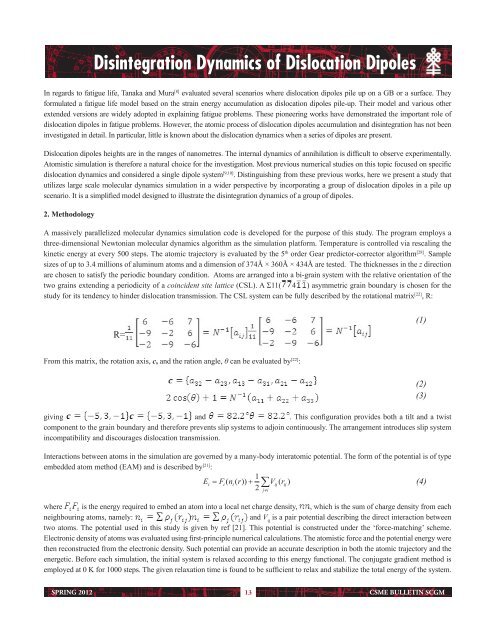Disintegration Dynamics of Dislocation Dipoles in Aluminum - CSME
Disintegration Dynamics of Dislocation Dipoles in Aluminum - CSME
Disintegration Dynamics of Dislocation Dipoles in Aluminum - CSME
Create successful ePaper yourself
Turn your PDF publications into a flip-book with our unique Google optimized e-Paper software.
<strong>Dis<strong>in</strong>tegration</strong> <strong>Dynamics</strong> <strong>of</strong> <strong>Dislocation</strong> <strong>Dipoles</strong><br />
In regards to fatigue life, Tanaka and Mura [8] evaluated several scenarios where dislocation dipoles pile up on a GB or a surface. They<br />
formulated a fatigue life model based on the stra<strong>in</strong> energy accumulation as dislocation dipoles pile-up. Their model and various other<br />
extended versions are widely adopted <strong>in</strong> expla<strong>in</strong><strong>in</strong>g fatigue problems. These pioneer<strong>in</strong>g works have demonstrated the important role <strong>of</strong><br />
dislocation dipoles <strong>in</strong> fatigue problems. However, the atomic process <strong>of</strong> dislocation dipoles accumulation and dis<strong>in</strong>tegration has not been<br />
<strong>in</strong>vestigated <strong>in</strong> detail. In particular, little is known about the dislocation dynamics when a series <strong>of</strong> dipoles are present.<br />
<strong>Dislocation</strong> dipoles heights are <strong>in</strong> the ranges <strong>of</strong> nanometres. The <strong>in</strong>ternal dynamics <strong>of</strong> annihilation is difficult to observe experimentally.<br />
Atomistic simulation is therefore a natural choice for the <strong>in</strong>vestigation. Most previous numerical studies on this topic focused on specific<br />
dislocation dynamics and considered a s<strong>in</strong>gle dipole system [9,10] . Dist<strong>in</strong>guish<strong>in</strong>g from these previous works, here we present a study that<br />
utilizes large scale molecular dynamics simulation <strong>in</strong> a wider perspective by <strong>in</strong>corporat<strong>in</strong>g a group <strong>of</strong> dislocation dipoles <strong>in</strong> a pile up<br />
scenario. It is a simplified model designed to illustrate the dis<strong>in</strong>tegration dynamics <strong>of</strong> a group <strong>of</strong> dipoles.<br />
2. methodology<br />
A massively parallelized molecular dynamics simulation code is developed for the purpose <strong>of</strong> this study. The program employs a<br />
three-dimensional Newtonian molecular dynamics algorithm as the simulation platform. Temperature is controlled via rescal<strong>in</strong>g the<br />
k<strong>in</strong>etic energy at every 500 steps. The atomic trajectory is evaluated by the 5 th order Gear predictor-corrector algorithm [28] . Sample<br />
sizes <strong>of</strong> up to 3.4 millions <strong>of</strong> alum<strong>in</strong>um atoms and a dimension <strong>of</strong> 374Å × 360Å × 434Å are tested. The thicknesses <strong>in</strong> the z direction<br />
are chosen to satisfy the periodic boundary condition. Atoms are arranged <strong>in</strong>to a bi-gra<strong>in</strong> system with the relative orientation <strong>of</strong> the<br />
two gra<strong>in</strong>s extend<strong>in</strong>g a periodicity <strong>of</strong> a co<strong>in</strong>cident site lattice (CSL). A Σ11( 4 ) asymmetric gra<strong>in</strong> boundary is chosen for the<br />
study for its tendency to h<strong>in</strong>der dislocation transmission. The CSL system can be fully described by the rotational matrix [22] , R:<br />
R=<br />
From this matrix, the rotation axis, c, and the ration angle, θ can be evaluated by [22] :<br />
From this matrix, the rotation axis, c, and the ration angle, θ can be evaluated by [22] :<br />
(2)<br />
(3)<br />
giv<strong>in</strong>g and . This configuration provides both a tilt and a twist<br />
component to the gra<strong>in</strong> boundary and therefore prevents slip systems to adjo<strong>in</strong> cont<strong>in</strong>uously. The arrangement <strong>in</strong>troduces slip system<br />
<strong>in</strong>compatibility and discourages dislocation transmission.<br />
Interactions between atoms <strong>in</strong> the simulation are governed by a many-body <strong>in</strong>teratomic potential. The form <strong>of</strong> the potential is <strong>of</strong> type<br />
embedded atom method (EAM) and is described by [21] (3)<br />
giv<strong>in</strong>g and . This configuration provides both a tilt and a twist<br />
component to the gra<strong>in</strong> boundary and therefore prevents slip systems to adjo<strong>in</strong> cont<strong>in</strong>uously. The<br />
arrangement <strong>in</strong>troduces slip system <strong>in</strong>compatibility and discourages dislocation transmission.<br />
Interactions between atoms <strong>in</strong> the simulation are governed by a many-body <strong>in</strong>teratomic potential.<br />
The form <strong>of</strong> the potential is <strong>of</strong> type embedded atom method (EAM) and is described by<br />
:<br />
[21] :<br />
1<br />
Ei � Fi<br />
( ni<br />
( r))<br />
� �Vij ( rij<br />
)<br />
(4)<br />
2 �<br />
(4)<br />
where is the energy required to embed an atom <strong>in</strong>to a local net charge density, , which is the sum <strong>of</strong> charge density from each<br />
(4)<br />
neighbour<strong>in</strong>g atoms, namely: and V is a pair potential describ<strong>in</strong>g the direct <strong>in</strong>teraction between<br />
ij<br />
two atoms. The potential where used is the <strong>in</strong> this energy study required is given to by embed ref [21]. an This atom potential <strong>in</strong>to a local is constructed net charge under density, the ‘force-match<strong>in</strong>g’ , which is the scheme.<br />
Electronic density <strong>of</strong> atoms was evaluated us<strong>in</strong>g first-pr<strong>in</strong>ciple numerical calculations. The atomistic force and the potential energy were<br />
sum <strong>of</strong> charge density from each neighbour<strong>in</strong>g atoms, namely: and Vij is a pair<br />
then reconstructed from the electronic density. Such potential can provide an accurate description <strong>in</strong> both the atomic trajectory and the<br />
energetic. Before each potential simulation, describ<strong>in</strong>g the <strong>in</strong>itial the direct system <strong>in</strong>teraction is relaxed accord<strong>in</strong>g between two to this atoms. energy The functional. potential The used conjugate <strong>in</strong> this gradient study is method is<br />
employed at 0 K for given 1000 by steps. ref The [21]. given This relaxation potential time is is constructed found to be under sufficient the to „force-match<strong>in</strong>g‟ relax and stabilize scheme. the total energy Electronic <strong>of</strong> the system.<br />
density <strong>of</strong> atoms was evaluated us<strong>in</strong>g first-pr<strong>in</strong>ciple numerical calculations. The atomistic force<br />
SPRING 2012 13<br />
<strong>CSME</strong> BULLETIN SCGM<br />
and the potential energy were then reconstructed from the electronic density. Such potential can<br />
provide an accurate description <strong>in</strong> both the atomic trajectory and the energetic. Before each<br />
j i<br />
simulation, the <strong>in</strong>itial system is relaxed accord<strong>in</strong>g to this energy functional. The conjugate gradient<br />
method is employed at 0 K for 1000 steps. The given relaxation time is found to be sufficient to<br />
relax and stabilize the total energy <strong>of</strong> the system.<br />
(2)<br />
(1)<br />
Formatted Table<br />
<strong>CSME</strong> Spr<strong>in</strong>g 2012.<strong>in</strong>dd 13 12-04-30 11:29 AM


